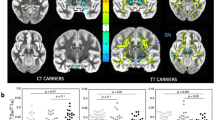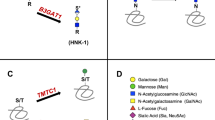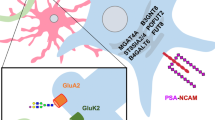Abstract
A missense mutation (A391T) in SLC39A8 is strongly associated with schizophrenia in genomic studies, though the molecular connection to the brain is unknown. Human carriers of A391T have reduced serum manganese, altered plasma glycosylation, and brain MRI changes consistent with altered metal transport. Here, using a knock-in mouse model homozygous for A391T, we show that the schizophrenia-associated variant changes protein glycosylation in the brain. Glycosylation of Asn residues in glycoproteins (N-glycosylation) was most significantly impaired, with effects differing between regions. RNAseq analysis showed negligible regional variation, consistent with changes in the activity of glycosylation enzymes rather than gene expression. Finally, nearly one-third of detected glycoproteins were differentially N-glycosylated in the cortex, including members of several pathways previously implicated in schizophrenia, such as cell adhesion molecules and neurotransmitter receptors that are expressed across all cell types. These findings provide a mechanistic link between a risk allele and potentially reversible biochemical changes in the brain, furthering our molecular understanding of the pathophysiology of schizophrenia and a novel opportunity for therapeutic development.
This is a preview of subscription content, access via your institution
Access options
Subscribe to this journal
Receive 12 print issues and online access
$259.00 per year
only $21.58 per issue
Buy this article
- Purchase on Springer Link
- Instant access to full article PDF
Prices may be subject to local taxes which are calculated during checkout



Similar content being viewed by others
Data availability
The data generated during this study are included in this published article and its supplementary information files, and available from the corresponding author on reasonable request. Raw MS glycomics data files are available through GlycoPOST [69] with the dataset identifier GPST000213. The RNAseq data discussed in this publication have been deposited in NCBI’s Gene Expression Omnibus [70, 71] and are accessible through GEO Series accession number GSE184516. The MS data were deposited at the ProteomeXchange Consortium [72] via the PRIDE partner repository and are available with the identifier PXD021632.
References
Marder SR, Cannon TD. Schizophrenia. N Engl J Med. 2019;381:1753–61.
Owen MJ, Sawa A, Mortensen PB. Schizophrenia. Lancet Lond Engl. 2016;388:86–97.
Millan MJ, Andrieux A, Bartzokis G, Cadenhead K, Dazzan P, Fusar-Poli P, et al. Altering the course of schizophrenia: progress and perspectives. Nat Rev Drug Discov. 2016;15:485–515.
Enna SJ, Bennett JP, Burt DR, Creese I, Snyder SH. Stereospecificity of interaction of neuroleptic drugs with neurotransmitters and correlation with clinical potency. Nature. 1976;263:338–41.
van Rossum JM. The significance of dopamine-receptor blockade for the mechanism of action of neuroleptic drugs. Arch Int Pharmacodyn Ther. 1966;160:492–4.
Howes O, McCutcheon R, Stone J. Glutamate and dopamine in schizophrenia: an update for the 21st century. J Psychopharmacol. 2015;29:97–115.
Avramopoulos D. Recent advances in the genetics of schizophrenia. Mol Neuropsychiatry. 2018;4:35–51.
Sullivan PF, Geschwind DH. Defining the genetic, genomic, cellular, and diagnostic architectures of psychiatric disorders. Cell 2019;177:162–83.
Smoller JW, Andreassen OA, Edenberg HJ, Faraone SV, Glatt SJ, Kendler KS. Psychiatric genetics and the structure of psychopathology. Mol Psychiatry. 2019;24:409–20.
Lee PH, Anttila V, Won H, Feng Y-CA, Rosenthal J, Zhu Z, et al. Genomic relationships, novel loci, and pleiotropic mechanisms across eight psychiatric disorders. Cell. 2019;179:1469–1482.e11.
Gottesman II, Shields J. A polygenic theory of schizophrenia. Proc Natl Acad Sci USA. 1967;58:199–205.
Schizophrenia Working Group of the Psychiatric Genomics Consortium. Biological insights from 108 schizophrenia-associated genetic loci. Nature. 2014;511:421–7.
Schizophrenia Working Group of the Psychiatric Genomics Consortium, Ripke S, Walters JT, O’Donovan MC. Mapping genomic loci prioritises genes and implicates synaptic biology in schizophrenia. medRxiv. 2020. https://doi.org/10.1101/2020.09.12.20192922.
Sekar A, Bialas AR, de Rivera H, Davis A, Hammond TR, Kamitaki N, et al. Schizophrenia risk from complex variation of complement component 4. Nature. 2016;530:177–83.
Presumey J, Bialas AR, Carroll MC. Complement system in neural synapse elimination in development and disease. Adv Immunol. 2017;135:53–79.
Yilmaz M, Yalcin E, Presumey J, Aw E, Ma M, Whelan CW, et al. Overexpression of schizophrenia susceptibility factor human complement C4A promotes excessive synaptic loss and behavioral changes in mice. Nat Neurosci. 2021;24:214–24.
Varki A, Cummings RD, Esko JD, Stanley P, Hart GW, Aebi M, et al., editors. Essentials of glycobiology. 3rd ed. Cold Spring Harbor (NY): Cold Spring Harbor Laboratory Press; 2015.
Varki A. Biological roles of glycans. Glycobiology. 2017;27:3–49.
Mealer RG, Williams SE, Daly MJ, Scolnick EM, Cummings RD, Smoller JW. Glycobiology and schizophrenia: a biological hypothesis emerging from genomic research. Mol Psychiatry. 2020. https://doi.org/10.1038/s41380-020-0753-1.
Ramakrishnan B, Ramasamy V, Qasba PK. Structural snapshots of β-1,4-galactosyltransferase-I along the kinetic pathway. J Mol Biol. 2006;357:1619–33.
Breton C, Šnajdrová L, Jeanneau C, Koča J, Imberty A. Structures and mechanisms of glycosyltransferases. Glycobiology. 2006;16:29R–37R.
Chang A, Singh S, Phillips GN, Thorson JS. Glycosyltransferase structural biology and its role in the design of catalysts for glycosylation. Curr Opin Biotechnol. 2011;22:800–8.
Park JH, Hogrebe M, Grüneberg M, DuChesne I, von der Heiden AL, Reunert J, et al. SLC39A8 deficiency: a disorder of manganese transport and glycosylation. Am J Hum Genet. 2015;97:894–903.
Park JH, Hogrebe M, Fobker M, Brackmann R, Fiedler B, Reunert J, et al. SLC39A8 deficiency: biochemical correction and major clinical improvement by manganese therapy. Genet Med. 2017. https://doi.org/10.1038/gim.2017.106.
Boycott KM, Beaulieu CL, Kernohan KD, Gebril OH, Mhanni A, Chudley AE, et al. Autosomal-recessive intellectual disability with cerebellar atrophy syndrome caused by mutation of the manganese and zinc transporter gene SLC39A8. Am J Hum Genet. 2015;97:886–93.
Riley LG, Cowley MJ, Gayevskiy V, Roscioli T, Thorburn DR, Prelog K, et al. A SLC39A8 variant causes manganese deficiency, and glycosylation and mitochondrial disorders. J Inherit Metab Dis. 2017;40:261–9.
Aguet F, Barbeira AN, Bonazzola R, Brown A, Castel SE, Jo B, et al. The GTEx Consortium atlas of genetic regulatory effects across human tissues. Science. 2020;369:1318–30.
Lonsdale J, Thomas J, Salvatore M, Phillips R, Lo E, Shad S, et al. The Genotype-Tissue Expression (GTEx) project. Nat Genet. 2013;45:580–5.
Saunders A, Macosko EZ, Wysoker A, Goldman M, Krienen FM, de Rivera H, et al. Molecular diversity and specializations among the cells of the adult mouse brain. Cell. 2018;174:1015–1030.e16.
Li M, Wu D-D, Yao Y-G, Huo Y-X, Liu J-W, Su B, et al. Recent positive selection drives the expansion of a schizophrenia risk nonsynonymous variant at SLC39A8 in Europeans. Schizophr Bull. 2016;42:178–90.
Buniello A, MacArthur JAL, Cerezo M, Harris LW, Hayhurst J, Malangone C, et al. The NHGRI-EBI GWAS Catalog of published genome-wide association studies, targeted arrays and summary statistics 2019. Nucleic Acids Res. 2019;47:D1005–D1012.
Hill WD, Marioni RE, Maghzian O, Ritchie SJ, Hagenaars SP, McIntosh AM, et al. A combined analysis of genetically correlated traits identifies 187 loci and a role for neurogenesis and myelination in intelligence. Mol Psychiatry. 2019;24:169–81.
Pickrell JK, Berisa T, Liu JZ, Ségurel L, Tung JY, Hinds DA. Detection and interpretation of shared genetic influences on 42 human traits. Nat Genet. 2016;48:709–17.
Kaufmann T, van der Meer D, Doan NT, Schwarz E, Lund MJ, Agartz I, et al. Common brain disorders are associated with heritable patterns of apparent aging of the brain. Nat Neurosci. 2019;22:1617–23.
Luo Q, Chen Q, Wang W, Desrivières S, Quinlan EB, Jia T, et al. Association of a schizophrenia-risk nonsynonymous variant with putamen volume in adolescents: a voxelwise and genome-wide association study. JAMA Psychiatry. 2019;76:435.
Ng E, Lind PM, Lindgren C, Ingelsson E, Mahajan A, Morris A, et al. Genome-wide association study of toxic metals and trace elements reveals novel associations. Hum Mol Genet. 2015;24:4739–45.
Zang Z-S, Xu Y-M, Lau ATY. Molecular and pathophysiological aspects of metal ion uptake by the zinc transporter ZIP8 (SLC39A8). Toxicol Res. 2016;5:987–1002.
Fujishiro H, Himeno S. New Insights into the Roles of ZIP8, a cadmium and manganese transporter, and its relation to human diseases. Biol Pharm Bull. 2019;42:1076–82.
Nebert DW, Liu Z. SLC39A8 gene encoding a metal ion transporter: discovery and bench to bedside. Hum Genomics. 2019;13:51.
Costas J. The highly pleiotropic gene SLC39A8 as an opportunity to gain insight into the molecular pathogenesis of schizophrenia. Am J Med Genet B Neuropsychiatr Genet. 2018;177:274–83.
Park JH, Mealer RG, Elias AF, Hoffmann S, Grüneberg M, Biskup S, et al. N-glycome analysis detects dysglycosylation missed by conventional methods in SLC39A8 deficiency. J Inherit Metab Dis. 2020. https://doi.org/10.1002/jimd.12306.
Lin W, Vann DR, Doulias P-T, Wang T, Landesberg G, Li X, et al. Hepatic metal ion transporter ZIP8 regulates manganese homeostasis and manganese-dependent enzyme activity. J Clin Investig. 2017;127:2407–17.
Mealer RG, Jenkins BG, Chen C-Y, Daly MJ, Ge T, Lehoux S, et al. The schizophrenia risk locus in SLC39A8 alters brain metal transport and plasma glycosylation. Sci Rep. 2020;10:13162.
Nakata T, Creasey EA, Kadoki M, Lin H, Selig MK, Yao J, et al. A missense variant in SLC39A8 confers risk for Crohn’s disease by disrupting manganese homeostasis and intestinal barrier integrity. Proc Natl Acad Sci USA. 2020. https://doi.org/10.1073/pnas.2014742117.
Williams SE, Noel M, Lehoux S, Cetinbas M, Xavier RJ, Sadreyev RI, et al. Mammalian brain glycoproteins exhibit diminished glycan complexity compared to other tissues. Nat Commun. 2022;13:275.
Terrillion CE, Kang B, Melia JMP. Behavioral phenotyping of Zip8 393T-KI mice for in vivo study of schizophrenia pathogenesis. BioRxiv. 2021. https://doi.org/10.1101/2021.10.18.464839.
Tosches MA, Yamawaki TM, Naumann RK, Jacobi AA, Tushev G, Laurent G. Evolution of pallium, hippocampus, and cortical cell types revealed by single-cell transcriptomics in reptiles. Science 2018;360:881–8.
Wei M, McKitrick TR, Mehta AY, Gao C, Jia N, McQuillan AM, et al. Novel reversible fluorescent glycan linker for functional glycomics. Bioconjug Chem. 2019;30:2897–908.
Schnaar RL, Gerardy-Schahn R, Hildebrandt H. Sialic acids in the brain: gangliosides and polysialic acid in nervous system development, stability, disease, and regeneration. Physiol Rev. 2014;94:461–518.
Watanabe K, Taskesen E, van Bochoven A, Posthuma D. Functional mapping and annotation of genetic associations with FUMA. Nat Commun. 2017;8:1826.
Mi H, Muruganujan A, Casagrande JT, Thomas PD. Large-scale gene function analysis with the PANTHER classification system. Nat Protoc. 2013;8:1551–66.
Das RC, Heath EC. Dolichyldiphosphoryloligosaccharide-protein oligosaccharyltransferase; solubilization, purification, and properties. Proc Natl Acad Sci USA. 1980;77:3811–5.
Shrimal S, Gilmore R. Oligosaccharyltransferase structures provide novel insight into the mechanism of asparagine-linked glycosylation in prokaryotic and eukaryotic cells. Glycobiology. 2019;29:288–97.
Bennett EP, Mandel U, Clausen H, Gerken TA, Fritz TA, Tabak LA. Control of mucin-type O-glycosylation: a classification of the polypeptide GalNAc-transferase gene family. Glycobiology. 2012;22:736–56.
Scott H, Panin VM. The role of protein N-glycosylation in neural transmission. Glycobiology 2014;24:407–17.
Live D, Wells L, Boons G-J. Dissecting the molecular basis of the role of the O-mannosylation pathway in disease: α-dystroglycan and forms of muscular dystrophy. ChemBioChem. 2013;14:2392–402.
Li Y, Ma C, Li W, Yang Y, Li X, Liu J, et al. A missense variant in NDUFA6 confers schizophrenia risk by affecting YY1 binding and NAGA expression. Mol Psychiatry. 2021. https://doi.org/10.1038/s41380-021-01125-x.
Li Y, Li S, Liu J, Huo Y, Luo X-J The schizophrenia susceptibility gene NAGA regulates dendritic spine density: further evidence for the dendritic spine pathology of schizophrenia. Mol Psychiatry. 2021. https://doi.org/10.1038/s41380-021-01261-4.
Williams SE, Mealer RG, Scolnick EM, Smoller JW, Cummings RD Aberrant glycosylation in schizophrenia: a review of 25 years of post-mortem brain studies. Mol Psychiatry. 2020. https://doi.org/10.1038/s41380-020-0761-1.
Mueller TM, Meador-Woodruff JH. Post-translational protein modifications in schizophrenia. Npj Schizophr. 2020;6:5.
Tseng WC, Reinhart V, Lanz TA, Weber ML, Pang J, Le KXV, et al. Schizophrenia-associated SLC39A8 polymorphism is a loss-of-function allele altering glutamate receptor and innate immune signaling. Transl Psychiatry. 2021;11:136.
Sunuwar L, Frkatović A, Sharapov S, Wang Q, Neu HM, Wu X, et al. Pleiotropic ZIP8 A391T implicates abnormal manganese homeostasis in complex human disease. JCI Insight. 2020;5:e140978.
Kwakye GF, Paoliello MMB, Mukhopadhyay S, Bowman AB, Aschner M. Manganese-induced Parkinsonism and Parkinson’s disease: shared and distinguishable features. Int J Environ Res Public Health. 2015;12:7519–40.
Madison JL, Wegrzynowicz M, Aschner M, Bowman AB. Gender and manganese exposure interactions on mouse striatal neuron morphology. Neurotoxicology. 2011;32:896–906.
Feldcamp L, Doucet J-S, Pawling J, Fadel MP, Fletcher PJ, Maunder R, et al. Mgat5 modulates the effect of early life stress on adult behavior and physical health in mice. Behav Brain Res. 2016;312:253–64.
Horning KJ, Caito SW, Tipps KG, Bowman AB, Aschner M. Manganese is essential for neuronal health. Annu Rev Nutr. 2015;35:71–108.
Dobin A, Davis CA, Schlesinger F, Drenkow J, Zaleski C, Jha S, et al. STAR: ultrafast universal RNA-seq aligner. Bioinformatics. 2013;29:15–21.
Anders S, Pyl PT, Huber W. HTSeq-a Python framework to work with high-throughput sequencing data. Bioinformatics. 2015;31:166–9.
Watanabe Y, Aoki-Kinoshita KF, Ishihama Y, Okuda S. GlycoPOST realizes FAIR principles for glycomics mass spectrometry data. Nucleic Acids Res. 2021;49:D1523–D1528.
Edgar R, Domrachev M, Lash AE. Gene Expression Omnibus: NCBI gene expression and hybridization array data repository. Nucleic Acids Res. 2002;30:207–10.
Barrett T, Wilhite SE, Ledoux P, Evangelista C, Kim IF, Tomashevsky M, et al. NCBI GEO: archive for functional genomics data sets-update. Nucleic Acids Res. 2013;41:D991–995.
Vizcaíno JA, Deutsch EW, Wang R, Csordas A, Reisinger F, Ríos D, et al. ProteomeXchange provides globally coordinated proteomics data submission and dissemination. Nat Biotechnol. 2014;32:223–6.
Acknowledgements
This work was supported by a foundation grant from the Stanley Center for Psychiatric Research at the Broad Institute of Harvard/MIT (awarded to RGM) and NIH grants P41GM103694 and R24GM137763 (awarded to RDC), and P30DK040561 (awarded to RIS). RGM is supported by T32MH112485 and a Dupont Warren Fellowship. CMW is supported by NIH NCI U01CA242098.
Author information
Authors and Affiliations
Contributions
RGM conceptualized the project, performed the bulk of experiments and analyses, and wrote the manuscript. SEW performed glycomics experiments and assisted with statistical analysis. MN performed quantitative glycan analyses and lectin blotting. BY and ADS performed glycoproteomic analysis. TN assisted in tissue harvest, genotyping, and mouse colony maintenance. DBG was involved in mouse generation. EAC was involved in mouse generation, genotyping, and colony maintenance. MC performed analysis of RNAseq data. RIS supervised RNAseq analysis. EMS initiated the project and coordinated collaborations. CMW supervised BY and ADS and oversaw glycoproteomic analysis. JWS co-supervised RGM and SEW, oversaw experimental analyses, and helped conceptualize the project. RJX provided mouse samples for analysis. RDC co-supervised RGM, SEW, and MN, oversaw experimental analyses, and helped conceptualize the project. All authors contributed feedback and edit to the manuscript.
Corresponding author
Ethics declarations
Competing interests
RJX is a cofounder and equity holder of Celsius Therapeutics and Jnana Therapeutics and consultant to Novartis. These companies did not provide support for this work. JWS is a member of the Scientific Advisory Board of Sensorium Therapeutics and has received honoraria for an internal seminar at Biogen, Inc and Tempus Labs. These companies did not provide support for this work. The remaining authors declare no competing interests.
Additional information
Publisher’s note Springer Nature remains neutral with regard to jurisdictional claims in published maps and institutional affiliations.
Supplementary information
Rights and permissions
About this article
Cite this article
Mealer, R.G., Williams, S.E., Noel, M. et al. The schizophrenia-associated variant in SLC39A8 alters protein glycosylation in the mouse brain. Mol Psychiatry 27, 1405–1415 (2022). https://doi.org/10.1038/s41380-022-01490-1
Received:
Revised:
Accepted:
Published:
Issue Date:
DOI: https://doi.org/10.1038/s41380-022-01490-1
This article is cited by
-
Genetic architecture of the structural connectome
Nature Communications (2024)



